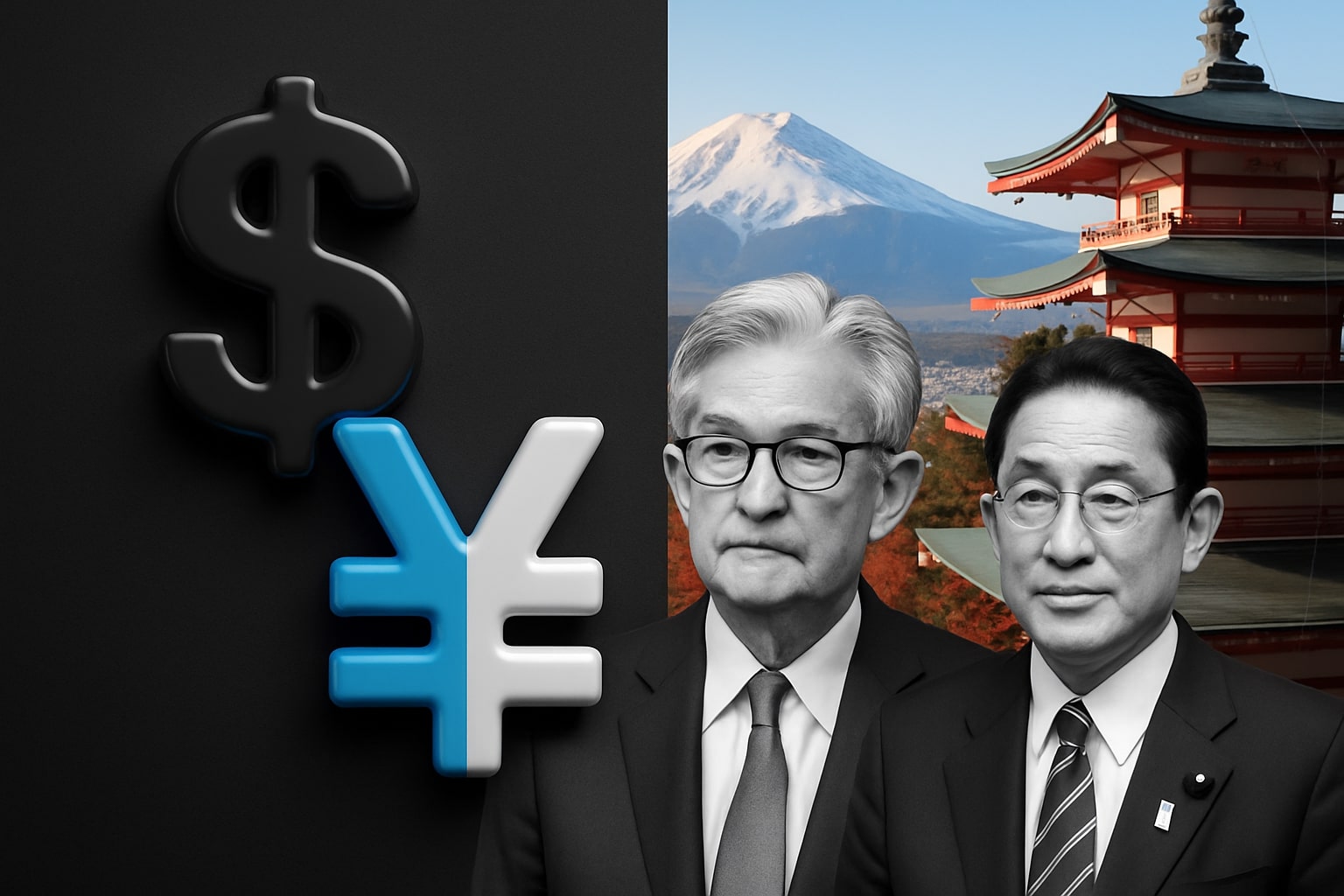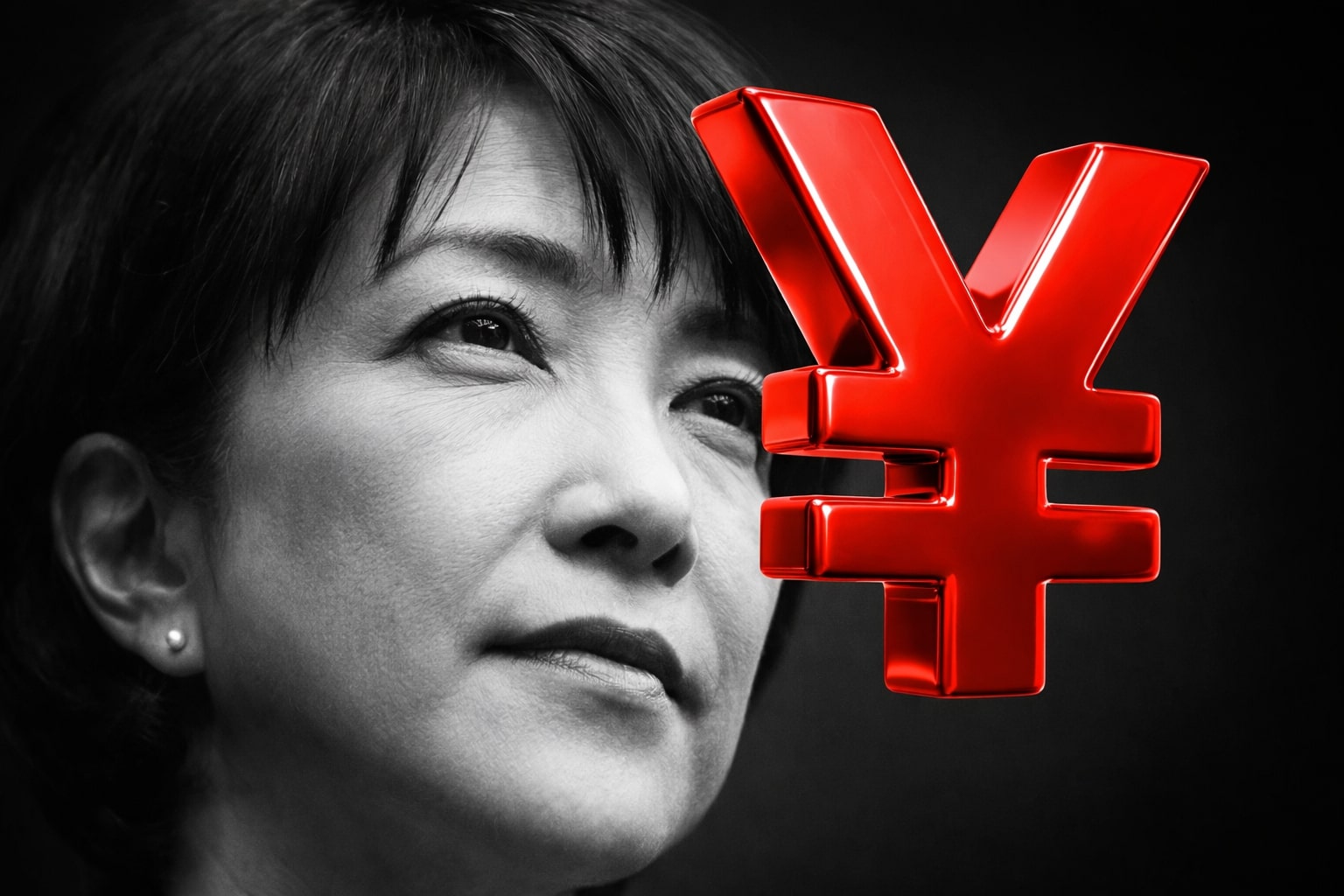
USD/JPY Price Forecast - Dollar to Yen Drops to 156.05 as Weak U.S. Data Shake Dollar Strength
: The yen rebounds from ten-month lows after Japan’s ¥21.3 trillion stimulus raises fiscal doubts and Tokyo signals readiness to intervene | That's TradingNEWS
USD/JPY Faces Pressure as Intervention Fears Collide with Weak U.S. Data and Japan’s Fiscal Strain
Dollar Retreats from Highs as Cooling U.S. Data Reinforces December Rate Cut Expectations
The USD/JPY pair slid toward 156.00, shedding around 0.45% on Tuesday as renewed intervention talk from Tokyo coincided with disappointing U.S. economic releases. The U.S. Producer Price Index (PPI) rose 0.3% month-on-month in September—inline with forecasts—but the core figure undershot expectations at 0.2%, pushing the annual rate down to 2.6% from 2.9%. Retail sales added pressure to the greenback, rising only 0.2% MoM, below the 0.4% consensus, while the control group, which feeds into GDP, contracted 0.1%, reversing the previous month’s 0.6% expansion. The data reinforced the narrative of cooling demand and softening inflation momentum. Coupled with a falling ADP Employment 4-week average to –13.5K, markets accelerated bets on a 25-basis-point Fed rate cut in December, with probabilities climbing to over 80% from just 42% a week earlier, according to CME FedWatch.
Fed Officials Signal Easing Bias, Limiting Dollar Momentum
Fed Governor Christopher Waller and New York Fed President John Williams both underscored that policy remains “moderately restrictive” and hinted at additional near-term easing. The shift pushed U.S. Treasury yields lower across the curve, narrowing the interest rate differential with Japan that had driven much of USD/JPY’s year-long rally. Despite a supportive risk environment, traders trimmed long-dollar positions, wary that an official Fed pivot could flatten the yield advantage sustaining the pair above 156.00. Equity markets surged—Nasdaq +2.4%, S&P 500 +1.4%, Dow Jones +0.6%—on expectations of lower rates, reinforcing the theme that monetary divergence between the Fed and the Bank of Japan (BoJ) may soon narrow.
Japan’s Authorities Intensify Verbal Intervention as Yen Nears Pain Threshold
Finance Minister Satsuki Katayama reiterated that Tokyo “will take appropriate action” against excessive currency volatility, signaling heightened readiness to intervene as USD/JPY trades near the 157.00 resistance zone. Takuji Aida, a senior economic adviser, added that Japan “can effectively intervene” to offset the negative impact of a weak yen. Markets view 160.00 as a critical intervention threshold, but traders note that psychological pressure may trigger preemptive action between 158–162. Historical precedent—Japan’s coordinated interventions in 2022 and 2024—continues to anchor expectations that sharp, speculative yen depreciation will not be tolerated.
Fiscal Stimulus and Debt Expansion Undermine Long-Term Yen Confidence
While intervention talk supports the yen near-term, Japan’s fiscal trajectory offsets much of the recovery momentum. The government’s approval of a ¥21.3 trillion stimulus package, its largest since the COVID-19 pandemic, amplified fears about rising sovereign debt. Yields on super-long Japanese Government Bonds (JGBs) surged to record highs, reflecting investor concern over debt sustainability. The Ministry of Finance plans to issue additional bonds to finance the supplementary budget, likely as early as November 28, deepening the imbalance between fiscal expansion and monetary restraint. Analysts warn that large-scale fiscal commitments could undermine confidence in the yen once intervention effects fade.
Bank of Japan Faces Policy Trap Between Inflation and Growth Contraction
The BoJ, led by Governor Kazuo Ueda, remains trapped between persistent inflation and faltering economic growth. Japan’s GDP contracted in Q3 2025 for the first time in six quarters, raising pressure to postpone further tightening. However, inflation has remained above 2% for over three years, with imported cost pressures still feeding through energy and food prices due to yen weakness. Ueda’s recent remarks to Parliament—acknowledging that a weak yen risks pushing up consumer prices—suggest the BoJ could still entertain a December rate hike, though the probability stands near 35%. Market participants remain skeptical, viewing policy normalization as gradual and data-dependent rather than imminent.
Fiscal-Monetary Divergence Drives Yen Volatility and Investor Hedging
Japanese equities remain resilient despite currency volatility, supported by export competitiveness. However, the safe-haven JPY has lost nearly 10% year-to-date against the dollar, reflecting chronic structural weakness. The divergence between massive fiscal spending and only marginal monetary tightening has left the USD/JPY pair in a narrow band, oscillating between 155.00–157.80. Investors are increasingly hedging exposure through JPY futures and options as policymakers’ verbal threats fail to produce sustained appreciation. Derivative volumes linked to the yen surged 18% month-over-month, according to CME data, underscoring heightened speculation ahead of potential intervention.
Technical Outlook: 157.00 Resistance and 155.40 Support Define the Range
From a technical perspective, USD/JPY remains range-bound. Bulls need confirmation above 157.00 to target 157.85–158.00, which would mark a fresh ten-month high. Failure to clear that region could invite renewed profit-taking toward 156.25 and 155.45 support. The 50-day exponential moving average, currently near 155.20, acts as the primary pivot. Below that, 154.50 emerges as a critical base, aligning with the former resistance zone turned support from mid-October. RSI remains neutral at 52, while MACD shows flattening momentum—signaling potential consolidation rather than a breakout.
Market Correlations: Cross-Currency Divergence Highlights Policy Disparity
The yen appreciated 0.45% versus the USD, 0.07% against the EUR, and 0.38% against the CHF, while gaining 0.69% versus the AUD, highlighting that risk-sensitive pairs remain under heavier pressure. The yen’s broad gains reflect risk aversion more than confidence in domestic fundamentals. Against commodity-linked currencies, particularly the AUD/JPY and CAD/JPY, the yen’s rebound shows speculative positioning rather than fundamental reversal. As energy imports and Japan’s trade balance remain negative, sustainable yen recovery requires either a BoJ policy shift or credible fiscal consolidation—neither of which appears imminent.
Read More
-
IVE ETF Near $212: Is This S&P 500 Value Play Still Cheap for 2026?
20.12.2025 · TradingNEWS ArchiveStocks
-
XRP ETFs XRPI at $11.07 and XRPR at $15.76 Power $1.2B Inflows as XRP Fights for $2
20.12.2025 · TradingNEWS ArchiveCrypto
-
Natural Gas Price Forecast: NG=F Tests $3.60 Support as LNG Boom and $5 Henry Hub Calls Build Into 2026
20.12.2025 · TradingNEWS ArchiveCommodities
-
USD/JPY Price Forecast - Pairs Surges After BoJ’s 0.75% Hike as Pair Eyes 161.50 Resistance
20.12.2025 · TradingNEWS ArchiveForex
Macro Sentiment: Fed Dovishness Limits Dollar Strength While BoJ Stays Cornered
The broader macro environment continues to favor the dollar on relative yield advantage but caps further appreciation due to the Fed’s dovish turn. Markets now expect three rate cuts in 2026, aligning with softening inflation and declining consumer spending. The U.S. Dollar Index trades around 100.1, stabilizing after touching a low of 100.01, indicating consolidation rather than breakdown. With U.S. labor data weakening and manufacturing indicators slipping, the fundamental ceiling for USD/JPY appears near 158.00, while intervention rhetoric acts as an upper constraint.
Investment View: Controlled Volatility but Limited Upside for USD/JPY
Combining all macro, policy, and technical indicators, USD/JPY (156.05) remains in a holding pattern. The probability of a Fed rate cut next month tempers dollar momentum, while Japan’s fiscal deterioration offsets yen support from intervention threats. Unless the BoJ delivers a concrete rate hike or the Fed delays easing, the pair is likely to consolidate within its existing band through December. Traders should monitor U.S. PPI, Retail Sales, and Japan CPI releases for directional cues.
Verdict: HOLD/NEUTRAL — USD/JPY maintains an upward bias capped by intervention risk. Near-term trading favors range strategies between 155.20 and 157.80, with a bias to fade rallies above 157.50 amid Fed easing expectations and Japan’s limited policy response.



















